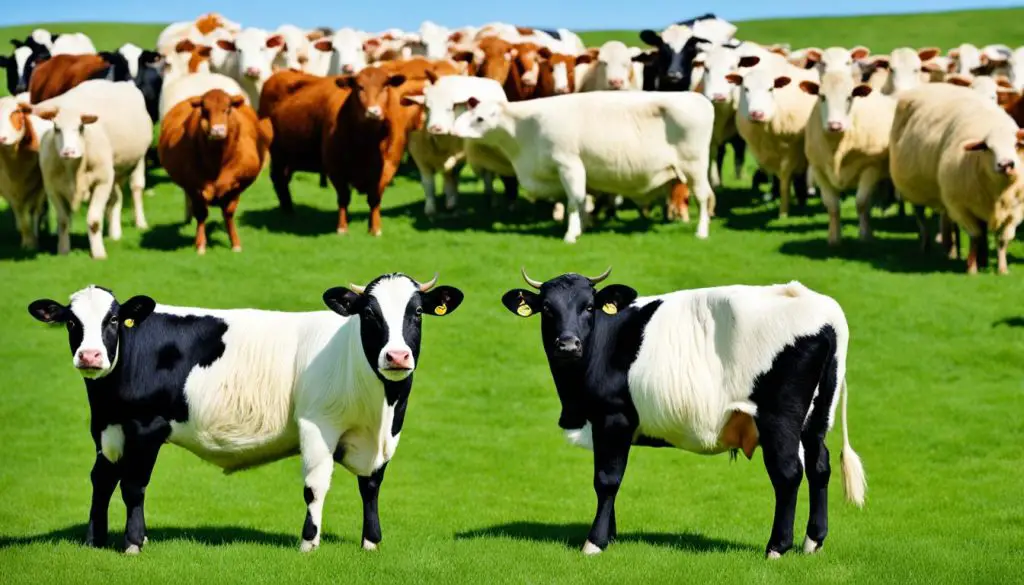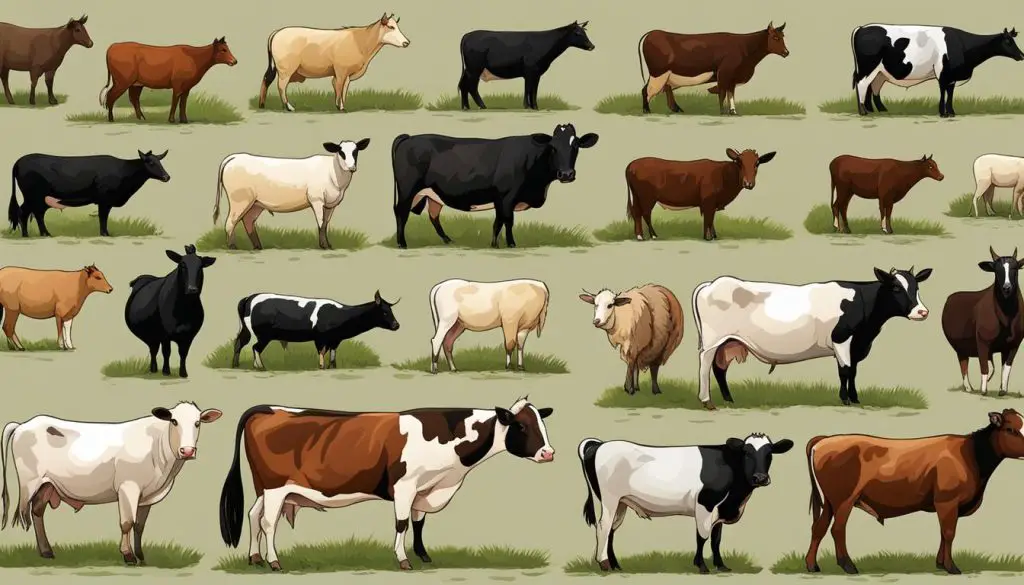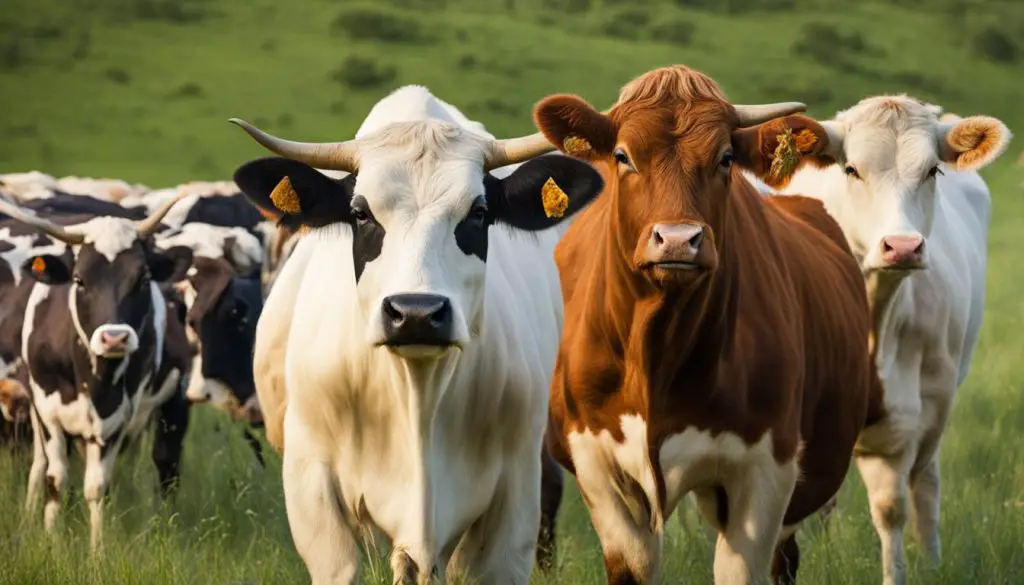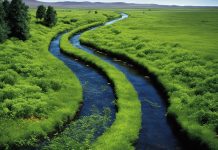‘Cattle’ is only used when talking about cows and bulls kept on a farm for milk or meat.
‘Livestock’ refers to all the animals that are kept on a farm for use and profit. For example, sheep, pigs, horses, and, of course, cows.
- Did you lose many cattle to wolves?
- There’s a fantastic market for livestock in that village. You can even buy camels and goats.

Key Takeaways
- Livestock characteristics span a spectrum of species, each with its role and product, from meat to milk and wool.
- Cattle vs livestock: while all cattle are livestock, not all livestock are cattle—an essential distinction in agriculture.
- Cattle, part of the genus Bos, are a major group in the livestock category and hold specific roles primarily in beef and dairy production.
- Understanding the distinctions between cattle and livestock can help inform sustainable agriculture practices and consumption choices.
- Awareness of livestock vs cattle characteristics is key to appreciating the diversity and complexity of animal husbandry.
Understanding the Scope of Livestock in Agriculture
As we dive into the vast world of animal husbandry practices, it’s fascinating to recognize the myriad of livestock breeds explained across different cultures and regions. These animals raised for consumption and labor are not limited to the well-known farm animals; they represent a key component of our global ecosystem. Let’s explore this diverse realm further.
Livestock Diversity: More Than Just Farm Animals
When I think about the species encompassed under the livestock umbrella, there’s an extensive list that goes much beyond common cattle. Here, in the United States, when we speak of livestock, we often think of cows and pigs; but globally, livestock characteristics vary drastically. The comparison of cattle and livestock reveals distinct purposes from dairy to draught, reflecting how cattle breed characteristics align with specific agricultural roles.
The Role of Livestock in Global Biomass
Did you know that the collective mass of livestock vs. cattle, especially ruminants like sheep and goats, adds significantly to the global vertebrate biomass? It’s true, that these farm animals outweigh humans and many wildlife species combined, signifying the profound influence of our animal husbandry practices on Earth’s biology and environmental landscapes.
Species Encompassed Under the Livestock Umbrella
Within the scope of livestock vs cattle, there’s a rich tapestry of creatures that support the foundations of agriculture worldwide. While the iconic image of cattle grazing on a bucolic farm is ingrained in our minds, other animals like the resourceful goats and sturdy horses also play significant roles in sustaining human livelihoods. Let’s take a closer look at how different livestock breeds contribute to our agricultural systems.
| Animal Category | Purpose | Characteristic Traits |
|---|---|---|
| Cattle | Meat, Dairy, Draft | Sizeable, Herbivorous, Suitable for Plowing |
| Sheep | Meat, Wool | Flocking Instinct, Grazers |
| Goats | Meat, Dairy, Fiber | Agile, Hardy, Adaptable to Varied Climates |
| Pigs | Meat | Intelligent, Omnivorous, Fast-growing |
| Horses | Labor, Transportation | Strong, Fast, Require Extensive Care |

What’s clear from this exploration is that both cattle versus other livestock fulfill pivotal roles not just in our diets, but in shaping the world we live in. As we deepen our understanding of livestock characteristics, we begin to appreciate the intricate balance between nature and the human endeavor of farming. Together, these farm animals form the backbone of rural economies and undoubtedly, our sustenance.
Differences Between Cattle and Livestock
When I delve into the farming world, I often encounter a common mix-up between ‘cattle’ and ‘livestock.’ To clarify, cattle are specifically domesticated bovines within the Bos genus, known for their indispensable role in meat, milk, and manual labor as draft animals. Conversely, livestock is an umbrella term that includes not just cattle but an array of domesticated animals such as sheep, goats, and pigs, all revered for their contributions to agriculture.
Exploring the unique cattle breed characteristics, I’ve observed that different breeds are tailored for varying purposes. For instance, beef production is dominated by breeds like the stately Angus and robust Hereford, while the gentle Jersey and prolific Holstein-Friesian cows excel in dairy. Livestock characteristics, however, span a broader spectrum, accounting for the distinctive traits of each species within this group.

A comparison of cattle and livestock reveals distinct roles that each type fulfills. While my experience with cattle is concentrated around the dairy shelves and butcher blocks, my interactions with pigs and poultry remind me of their importance in meat and egg production. Here’s a table that further elucidates the distinguishing features:
| Cattle | Other Livestock |
|---|---|
| Primarily used for beef and dairy products | Diverse uses including meat, dairy, eggs, and labor |
| Includes draft animals, often oxen | Encompasses species like pigs, known for pork, and sheep, for wool and mutton |
| Bulls and cows have specific roles in breeding and production | Animals such as goats and chickens serve multiple roles in farming practices |
Oxen, a term used for cattle trained as draft animals, usually castrated males, present a sharp contrast to the uncastrated, fiercer bulls. Understanding the distinguishing features of cattle and livestock is crucial for anyone interacting with the agricultural world, whether as a farmer making breeding decisions or a consumer selecting products at the grocery store.
Conclusion
As we wrap up this exploration, I’ve found that the nuances defining cattle characteristics and livestock characteristics aren’t just academic distinctions—they reflect the very framework of our agricultural systems. While cattle, with their specialized role in the production of beef and dairy, stand as a significant sector within agriculture, the term livestock widens the lens to include a variety of farm animals integral to our dietary and labor needs.
Summarizing the Distinguishing Features of Cattle and Livestock
The differences between cattle and livestock extend from basic biology to the breadth of utility they offer. As a focused subgroup, cattle have been selectively bred for particular ends, shaping not only their physical form but also their contributions to agricultural outputs. On the other hand, when we speak of livestock vs cattle, we acknowledge a spectrum of species, each with distinct roles that bolster the resilience and adaptability of farming practices worldwide.
Implications of Classification on Farming and Consumption
The way we classify these animals influences everything from legislative frameworks to the ethical considerations on farms, guiding how we support the welfare of the creatures under human care. Knowledgeable about these classifications, I understand that my choices as a consumer can impel shifts in agricultural practices and livestock consumption trends, enabling sustainable solutions that consider both the health of our planet and those who inhabit it. Consequently, these delineations are more than categorical; they are fundamental to our approach to food security and stewardship of the earth’s resources.
FAQ
What distinguishes cattle from other types of livestock?
Cattle specifically refer to domesticated bovines within the Bos genus and are primarily raised for meat, milk, and as draft animals. Other livestock include a wide range of domesticated farm animals such as sheep, goats, pigs, horses, and others that are raised for a variety of purposes, including work, meat, dairy, and wool. The main distinguishing features are the specific uses and characteristics associated with cattle versus the broader category of animals encompassed by the term livestock.
What are the main purposes of raising livestock?
Livestock are raised for various purposes including labor, meat, milk, eggs, fur, leather, and wool. They play a critical role in agriculture, providing essential products for human consumption and use. The specific purpose often depends on the type of livestock and the context of the farming practice.
Which animals are considered livestock?
Livestock encompasses a broad category of domesticated farm animals. In Western countries, this typically includes cattle, sheep, pigs, goats, horses, and donkeys. In other regions, the term may also cover buffalo, oxen, llamas, and camels. The classification varies depending on cultural and geographical contexts.
What is animal husbandry and its significance?
Animal husbandry is the practice of breeding and raising livestock. It has been a pivotal element in the development of agriculture, from hunter-gatherer communities to settled farming societies. It plays a vital role in economies and cultures by influencing economic systems and providing necessary resources for human survival.
How do intensive farming practices affect livestock and the environment?
Intensive farming practices focus on maximizing commercial outputs of livestock but can raise significant concerns regarding animal welfare, environmental impact, and public health. These practices contribute to increased emissions, particularly from cattle and sheep, and they can also lead to deforestation, water pollution, and loss of biodiversity.
What are the differences in roles between cattle and other livestock?
Cattle are primarily used for beef and dairy production and sometimes as draft animals, while other livestock such as pigs and poultry are more commonly raised for meat and eggs. Sheep and goats are often raised for meat and wool, and horses can be used for labor, transportation, and recreational purposes.
What are popular cattle breeds and their purposes?
Popular beef cattle breeds include Hereford, Shorthorn, and Angus, which are celebrated for their meat quality. Meanwhile, dairy cattle breeds like Holstein-Friesian, Jersey, and Guernsey are highly valued for milk production. These breeds have specific characteristics that make them suitable for their respective roles in agriculture.
What is the contribution of livestock to global biomass?
Livestock contribute significantly to vertebrate biomass on Earth, with their mass surpassing that of both humans and wild terrestrial vertebrates combined. This reflects the profound impact of human agricultural practices. Ruminants such as cattle, sheep, and goats are central to this change, dramatically altering ecosystems and resource distribution.
Why is the classification between cattle and other livestock important?
The classification between cattle and other livestock is important for understanding farming practices, regulations, and consumption patterns. It informs stakeholders ranging from farmers to consumers about production methods, animal welfare, dietary choices, and the role of agricultural diversity in supporting livelihoods and ensuring food security around the world.


























